ABSTRACT
This research was carried out to assess the plant species diversity in Nasarawa State, Nigeria with a view to obtain an accurate database and inventory of the naturally occurring plant species in the state for reference and research purposes. This preliminary report covers a total of nine local government areas in the state. The work involved intensive survey and visits to the sample sites for this exercise. The diversity status of each plant and the distribution across the state were also determined using standard method. A total of number of 244 plant species belonging to 57 plant families were identified out of which the families, Asteraceae, Poaceae, Combretaceae, Euphorbiaceae, Moraceae and Papilionaceae were the most highly distributed across the entire study area. There was great extent of diversity in the distribution of plants across all the areas sampled with the highest in Wamba LGA. The most predominant food crop across the state was Sorgum spp. followed by Sesame indica and then Zea mays. The total percentage occurrence of herbs, shrubs and trees in the study area are 31.19, 16.29 and 47.91%, respectively. This preliminary work has provided a baseline data and reference point for future taxonomical stratagem in Nasarawa State.
Key words: Herbarium, conservation, Nasarawa, plant diversity.
Biological diversity or biodiversity refers to the variability among living organisms from all sources including, terrestrial, marine and other aquatic ecosystems and the ecological complexes of which they are part. It encompasses the variety of all forms of life on earth, which provides the building blocks for human existence and ability to adapt to environmental changes in the future (FEPA, 2003). Biological diversity involves genetic, species and ecosystem diversity. Estimates of the total number of species range from 5 million to 100 million globally; though less than 1.7 million have actually been described (FEPA, 2003). Species diversity remains central to the evaluation of diversity at other levels, and is a constant point of reference in biodiversity conservation. Conservation is the planned management of natural resources, to retain the natural balance, diversity and evolutionary change in the environment. It is a protective measure taken; to prevent the loss of genetic diversity of a species; to save a species from becoming extinct and to protect an ecosystem from damage so as to promote its sustained utilization. Plant germplasm is a non-renewable natural resource indispensable for the sustenance of human life on this earth (Borokini et al., 2010).
Nigeria is one of the most populous countries in Africa and has a landmass of over 923,768 squ km including about 13,000 sq km of water (NBS, 2007). There is an array of flora and fauna species associated with the varied ecological zones in Nigeria. There are 7,895 plant species from 338 families and 2,215 genera that have been identified in Nigeria (FGN, 2006). According to the FAO Forest Resources Assessment Report, Nigeria has the highest rate of deforestation of primary forests between 2000 and 2005 (FAO, 2005). The great diversity of plant species found in Nigeria cannot be unconnected with the diversity of ecosystems and habitats as well as the tropical climate in the country (FEPA, 1992). Nasarawa State is one of the states in the North-Central geo-political zones in Nigeria. It is bounded in the north by
Kaduna State, in the west by the
Abuja Federal Capital Territory, in the south by
Kogi and
Benue States and in the east by
Taraba and
Plateau States. It has a total land area of 27,137.8 sqkm (NPC, 2006). Nasarawa’s main economic activity is agriculture. Production of minerals such as salt is also another major economic activity in the state. It lies within the guinea Savannah region and has tropical climate with moderate rainfall (annual mean rainfall of 1311:75 cm) (Nyagba, 1995). The state is made up of plain lands and hills and has some of the most beautiful sites and landscapes in the country.
There is still a lack of quantitative information on naturalized plants for major regions of the world, especially for those of Asia and Africa. Floras of these regions are either not existent or are incomplete, making it difficult to assess the native plant diversity populations. It is very true that many of our valuable plant generic resources are fast disappearing due to afore mentioned reasons and there is a careful need to document current plant diversity status so as to guide in the conservation plans to salvage the residual diversity. This study provides specific and comprehensive information on the species enumeration, diversity and conservation status of the plants in Nasarawa State, Nigeria.
Sampling areas
Nine out of thirteen local government areas of Nasarawa State were selected at random and sampled for this study namely: Akwanga, Awe, Keffi, Kokona, Nasarawa, Nasarawa Eggon, Toto, Obi and Wamba (Figure 1).
Sample collection
This study involved intensive survey and several visits to the sample sites for plant identification and enumeration exercise.
Surveys and direct field observation were carried out as done in previous works (Lipp, 1989; Kayode et al., 1997). In each of the selected local government area, two rural communities, with plant richness and still far from urban influence were sampled. The Origin, life form and habitats colonized by each species were identified as far as possible. Life samples were collected and preserved using plant presses. The identification of the plants was done on the spot and with the aid of published floral and taxonomic books (NNMDA, 2006; 2008). A few unidentified plants were sent to standard herbaria for proper identification.
Species abundance
The relative abundance of the identified botanicals within 2 km radius from each of the sampling centers were determined according to Bongers et al. (1988) and Kayode (1999) as: Less than 5 individuals as rare, 5 to 10 as occasional, 11 to 30 as frequent, 31 to 100 as abundant and over 100 individuals as very abundant.
A total number of 244 plant species of different families were identified. There was great diversity in the distribution of plants across all the local governments sampled. However, the highest plant diversity in terms of different species was recorded in Wamba local government area (Table 1).
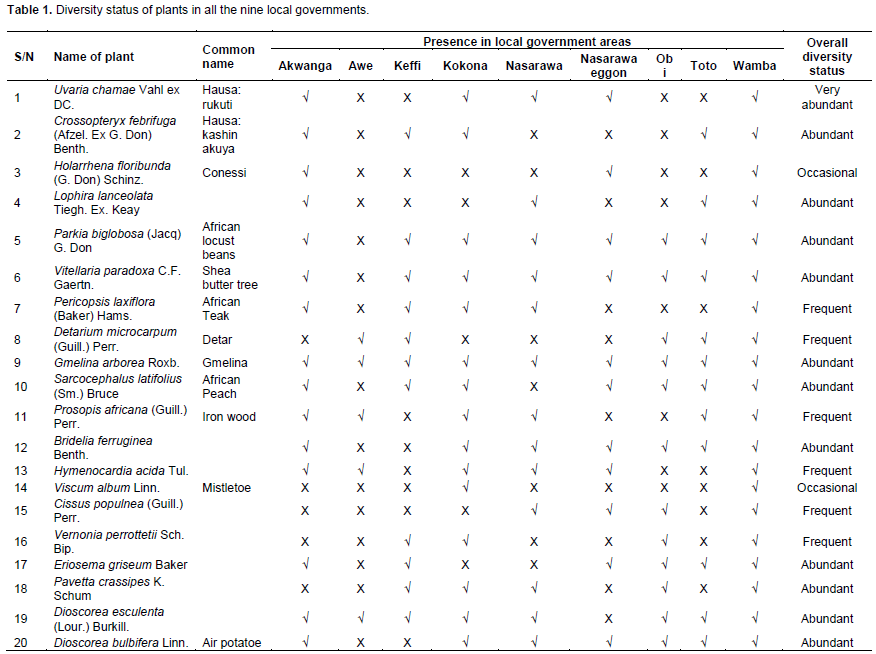
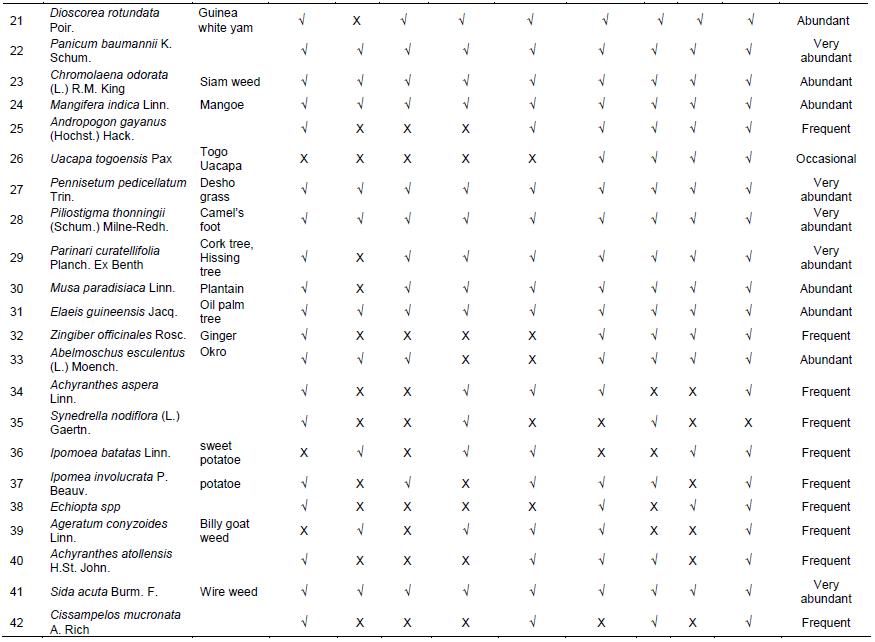
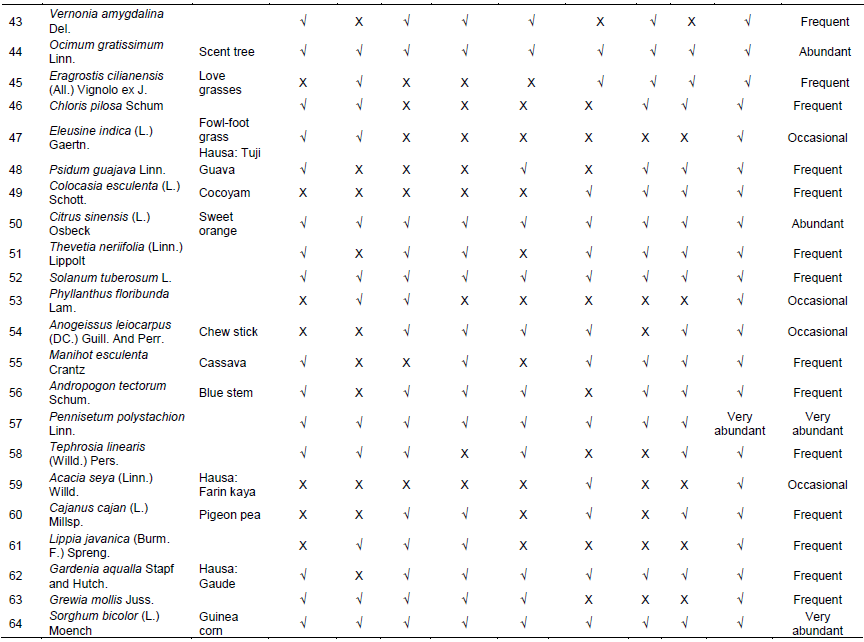

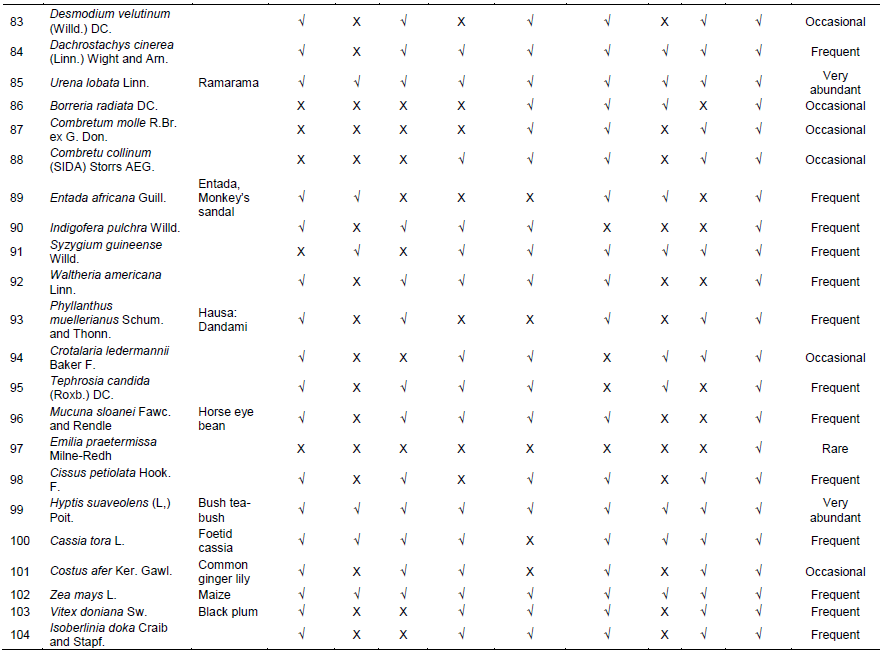


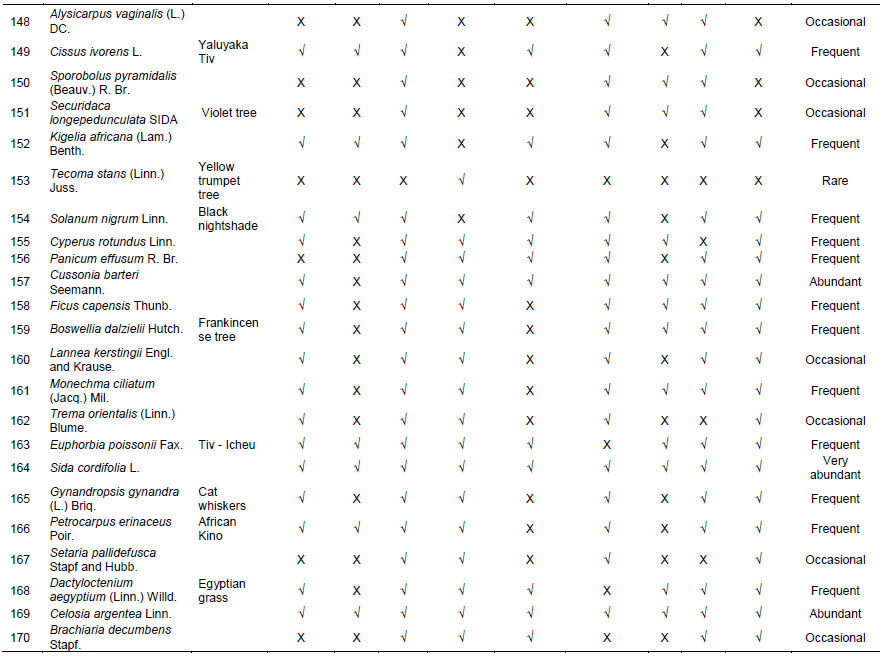

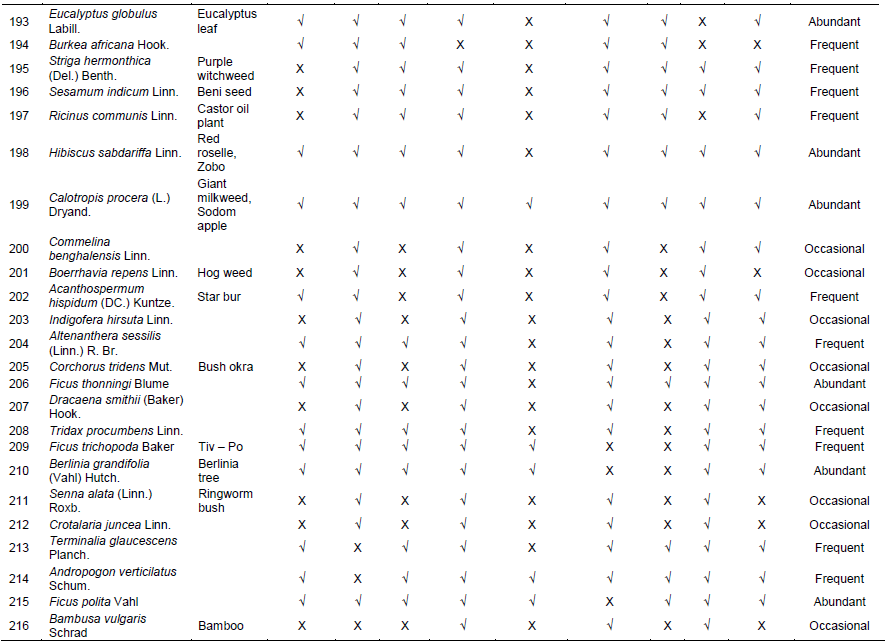


Three plants have been identified as rare species namely Emilia praetermissa, Tecoma stans and Phyllanthus amarus. The total percentage occurrence of herbs, shrubs and trees in the 9 local governments are 31.19, 16.29 and 47.91%, respectively (Table 2). A total of 57 plant families were identified out of which the families Asteraceae, Poaceae, Combretaceae, Euphorbiaceae, Moraceae and Papilionaceae were the most highly distributed across the entire 9 local government areas (Table 3). Poaceae family has the highest overall percentage distribution across the entire nine local government areas. The predominant food crops in all the local governments are Musa sapientum Zea mays, Sorghum bicolor, Curcubita spp. and Sesame indica (Table 4). Trees have the highest percentage occurrence and spread across the entire areas sampled in the state. Awe local government area has the lesser diversity of plant species.
The lower percentage distribution recorded in some of the identified plant families could be attributed to some of the factors affecting indigenous biodiversity in Nigeria. The destruction of natural habitats as observed by Imeht and Adebobola (2001) continues in Nigeria at a rapid rate in which about 65 of 560 species of trees are now faced with extinction, while many others are at different stages of risk; thereby, leading to the depletion of the country’s biodiversity. Awe local government area which recorded the lowest diversity of plant species is suspected to be due to the effects of intensive salt mining activities in the area. However, the outcome of this research agrees with the report of Kutama et al. (2015) that Nigeria is so much blessed with almost uncountable number of plant species.
The massive rate of deforestation is a direct cause of biodiversity loss (Borokini et al., 2010) and Nigeria has been declared to have the highest rate of deforestation of primary forests in the world (FAO, 2005). Also, Eneobong (1997), reported that the rapid reducing rate of Africa’s forests and bioresources is linked with civil war, conversion of land for agriculture, wild fires, poor management of available land, uncontrolled search for food, fuel wood, medicine, construction timber, over-grazing by cattle, displacement and loss of landraces, lower yielding varieties, pests and diseases, pollution (e.g. acid rain) and incomplete knowledge of the biology of many plants, especially the propagation genetics aspect and adaptability of many forest plants.
Furthermore, Nasarawa state has been described as an agrarian state with large percentage of the masses engaged in farming of crops such as sorghum, sesame, cassava and agro-allied activities (Abu et al., 2012). Farming and cultivation of food crops have dominated some of the local governments in the state such as Obi, Kokona, Akwanga, Nasarawa and Keffi leading to loss of some plants species.
This is similar to the report of Aliyu et al. (2013) on the impact of deforestation on the socio-economic activities of Akwanga, Nasarawa State that the area has been seriously affected negatively by erosion, bush-burning and fire-wood fetching activities. According to Uyoh et al. (2003), there has to be a balance between the uses of bioresources and their conservation thereby preserving an ecosystem, which although altered would still be rich in bioresources and at the same time would provide food and other needs as well as perform vital environmental functions on a long term basis.
The highest plant diversity distribution observed in Wamba Local Government Area could be attributed to lesser disturbances of the natural ecosystem. In addition, there is a large area of protected land by government in this local government. In line with the mandate of some governmental agencies and NGOs like Nigerian conservation foundation (NCF), the National Resources Council (NARECO) in collaboration with the United Nations Environmental Programme (UNEP) and the World Wide Fund (WWF) engaged in protecting and preserving the country’s biodiversity, this research has provided a baseline account of the preponderance diversity status of some of the plants in Nasarawa State. Three plants Emilia praetermissa, Tecoma stans and Phyllanthus amarus were identified as rare species and deliberate conservation strategies need to be adopted appropriately to avoid total genetic erosion or extinction.
Of these valuable species. In addition, the loss of biodiversity due to deforestation should be minimized when it is necessary to utilize natural vegetation in order to create industrial development (Akinnibosun and Omatsola, 2011). This preliminary work has provided a baseline data and reference point for future taxonomical and biosystematics stratagem in Nasarawa State. It is thereby recommended that priority must be placed on creating protected areas across all the local government areas that will prevent indiscriminate exploitation of plant resources in Nasarawa State. Also, the use and implementation of the Environmental Impact Assessment (EIA) before embarking on any construction projects in the state must be encouraged.
The authors have not declared any conflict of interest.
The authors wish to thank the Management of TETFUND for the research grant awarded to conduct this study and the Management of the Federal University Lafia for permission and support to carry out the research.
REFERENCES
|
Abu GA, Ater PI, Abah D (2012). Profit Efficiency among Sesame Farmers in Nasarawa State, Nigeria. Curr. Res. J. Soc. Sci. 4(4):261-268.
|
|
|
|
Akinnibosun HA, Omatsola ME (2011). Baseline studies of the floral biodiversity of a proposed crude oil exploration field in Edo State, Nigeria. Sci. World J. 6(1):1
|
|
|
|
|
Aliyu A, Modibbo MA, Medugu NI, Ayo O (2013). Impacts of deforestation on socio-economic development of Akwanga Nasarawa State. Int. J. Sci. Environ. Technol. 3(2):403-416.
|
|
|
|
|
Bongers F, Popma J, Meave del Castillo J, Carabias J (1988). Structure and floristic composition of the lowland rainforest of Los Tuxtlos, Mexico. Vegetatio 74:55-80.
Crossref
|
|
|
|
|
Borokini TI, Okere AU, Giwa AO, Daramola BO, Odofin WT (2010). Biodiversity and conservation of plant genetic resources in Field Genebank of the National Centre for Genetic Resources and Biotechnology, Ibadan, Nigeria. Int. J. Biodivers. Conserv. 2(3):037-050.
|
|
|
|
|
Eneobong EE (1997). Biotechnological techniques for the conservation and use of plant genetic resources. In E.E Eneobong (ed.) Biological Conservation for sustainable agricultural production, Federal University of Agriculture Umudike, Nigeria pp.72-75.
|
|
|
|
|
Food and Agriculture Organization (FAO) (2005). State of the World's Forests 2005. FAO, Rome, Italy.
|
|
|
|
|
Federal Environmental Protection Agency (FEPA) (1992). Federal Environmental Protection Agency. Biological Diversity in Nigeria, ACountry Study 1991-1992.
|
|
|
|
|
Federal Environmental Protection Agency (FEPA), (2003). National Biodiversity Strategy and Action Plan.
|
|
|
|
|
Federal Government of Nigeria (FGN) (2006). Draft Report. National Capacity Needs Self-Assessment for Environmental Management. Federal Ministry of Environment.
|
|
|
|
|
Iment N, Adebobola N (2001). The effects of poverty in conservation of Biodiversity: The Nigeria Experience.
|
|
|
|
|
Kayode J (1999). Phytosociological investigation of compositae weeds in abandoned farmlands in Ekiti State, Nigeria. Compositae Newsletter 34:62-68.
|
|
|
|
|
Kayode J, Ibitoye OA, Olufayo O (1997). Private participation in taungya agroforestry in Ondo-Ekiti Region: Problems and prospects. Int. J. Urban Reg. Affairs 1(1):54-57.
|
|
|
|
|
Kutama AS, Dangora II, Aisha W, Auyo MI, Sharif U, Umma M, Hassan KY (2015). An overview of plant resources nd their economic uses in Nigeria. Global Adv. Res. J. Agr. Sci. 4(2):042-067.
|
|
|
|
|
Lipp FJ (1989). Methods of Ethno-pharmacological field work. J. Ethno-pharmacol. 25, 139-150.
Crossref
|
|
|
|
|
National Bureau of Statistics (NBS) (2007). 2006 Population Census. Available at www.nigerianstat.gov.ng
|
|
|
|
|
National Population Commission, Nigeria, (NPC) (2006). Census Report.
|
|
|
|
|
Nigeria Natural Medicine Development Agency (NNMDA) (2006). Medicinal Plants of Nigeria; North Central Nigeria. Federal Ministry of Science and Technology, vol. 1
|
|
|
|
|
Nigeria Natural Medicine Development Agency (NNMDA) (2008). Biodiversity of the Sukur World heritage site, Adamawa State, North East Nigeria. Federal Ministry of Science and Technology.
|
|
|
|
|
Nyagba JL (1995). The Geography of Benue State. In: Denga Dl ed. Benue State: The Land of Great Potentials. Calabar: Rapid Educational Publishers pp.84-97.
|
|
|
|
|
Uyoh EA, Nkang AE, Eneobong EE (2003). Biotechnology, genetic conservation and sustainable use of bioresources. Afr. J. Biotechnol. 2(12):704-709.
Crossref
|
|